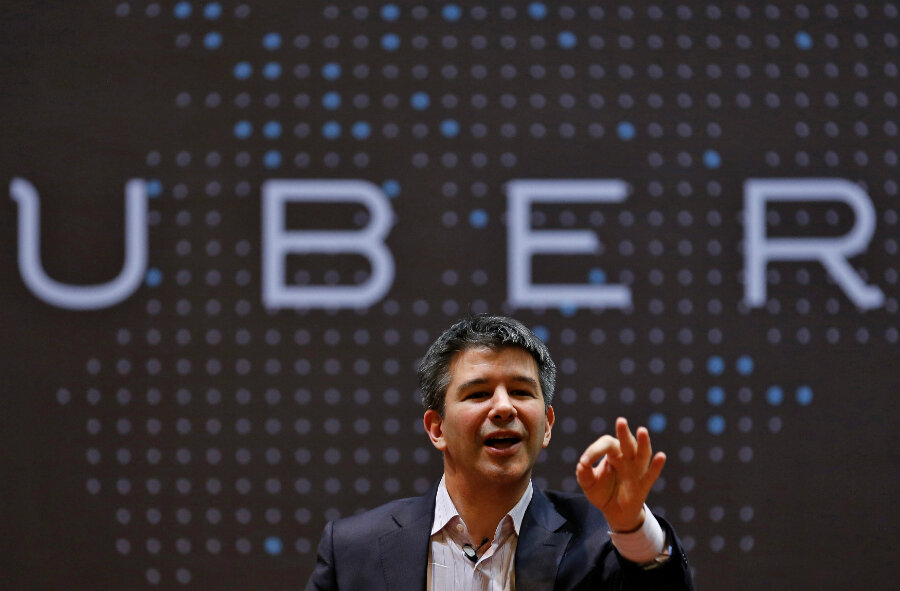In light of image problems, Uber tries the humility game
Loading...
Uber's public relations team has been working overtime the past couple of months, thanks in large part to the antics of Uber's brash bro of a CEO, Travis Kalanick.
In January, the man at the top of Uber's org chart did a lousy job of justifying his participation on Trump's business council following the president's issuance of a travel ban targeted at Muslim-majority countries. Kalanick has also been accused of fostering a workplace environment that's hostile to women and LGBT employees, and the cherry on bottom was a dashcam video of Kalanick berating one of his own Uber drivers.
To be sure, Kalanick himself isn't solely responsible for Uber's current woes, but his "ask for forgiveness, not permission" leadership style set a tone that appears to have infiltrated the entire company. Recently, Uber has tried to reverse course by playing the humility game, and believe it or not, the strategy is paying off.
Good news #1
Back in December, Uber launched a fleet of 16 self-driving vehicles in San Francisco, much as it had done last August in Pittsburgh.
Unfortunately, Uber hadn't filed the necessary paperwork to make those vehicles street-legal in California, and the state's Department of Motor Vehicles threatened to run the entire program off the road if Uber didn't apply for an autonomous car testing permit like 26 other companies had done. Kalanick glibly responded that Uber didn't need such a permit because its cars weren't technically autonomous, since they had human monitors in the driver's seats.
The DMV wasn't having any of Kalanick's sass. One week later, Uber's San Francisco program was curbed and subsequently moved to Arizona.
Uber took it on the chin, talking up Arizona's more business-friendly environment. However, it was abundantly clear that Kalanick and Co. wanted to motor back to their hometown. And so, hat in hand, the company recently shelled out a $150 fee and formally applied for permission to test its self-driving vehicles on California roads.
Mere days later, California approved Uber's application, paving the way for the company's return to San Francisco.
At the moment, the company has two self-driving cars roaming the city's streets, and as more vehicles cross the standard regulatory hurdles (e.g. smog tests), the fleet will grow.
Uber users can't request a ride in the autonomous vehicles just yet. The company hasn't indicated when it will offer autonomous service to the public--and even when it does, there will still be a human in the driver's seat.
Good news #2
In unrelated good news, Uber has stopped using a program called Greyball to help drivers dodge regulators--a practice that did little to improve officials' feelings about the company.
The software has been running on the backend of Uber's ride-hailing app. In cities that hadn't yet given Uber the green light to operate, Greyball would try to screen out regulators who might attempt to secure Uber rides and thereby bring the company's operations to a halt.
Greyball looked at several key pieces of information to suss out whether a potential rider might be a regulator. That information included the person's location (e.g. whether the person was standing near a government building when the ride was hailed); the user's credit card (e.g. whether it was linked to a governmental or law enforcement agency); and sometimes the phone itself, which Uber might've identified as a "burner" phone purchased by regulators for entrapment purposes.
Uber self-driving prototype in San Francisco
Now, that practice has ended, though Uber says that it will continue using Greyball for other ends, like marketing to users, protecting drivers from harm, and keeping competitors from disrupting Uber's business.
Bad news
That said, it's not all rainbows and unicorns for Uber these days. The head of the company's new artificial intelligence program, AI Labs, Gary Marcus, has announced his departure just three months into the job.
AI Labs is a key player in developing Uber's proprietary self-driving software, as well as the technology that helps identify travel routes for drivers and match riders using UberPOOL. Marcus joined the Uber team in December when his AI company, Geometric Intelligence, was acquired by Uber and its staff became AI Labs' first employees.
Uber hasn't commented on the departure, and Marcus hasn't said anything other than that he's looking forward to spending more time with his family (tried-and-true phrasing that may not give an accurate picture of his departure). He notes, however, that he'll continue working with Uber as a "Special Advisor for AI".
Marcus' resignation probably won't have much of an impact on Uber's self-driving program. However, it could be a signal that something is deeply wrong with Uber's current culture. If so, other high-profile departures could follow.
This story originally appeared on The Car Connection.





